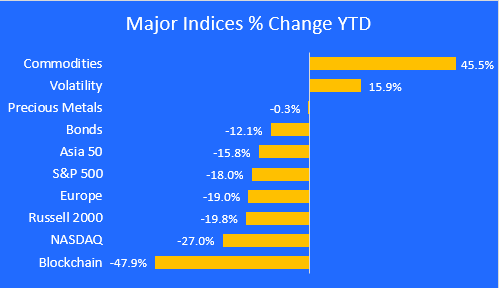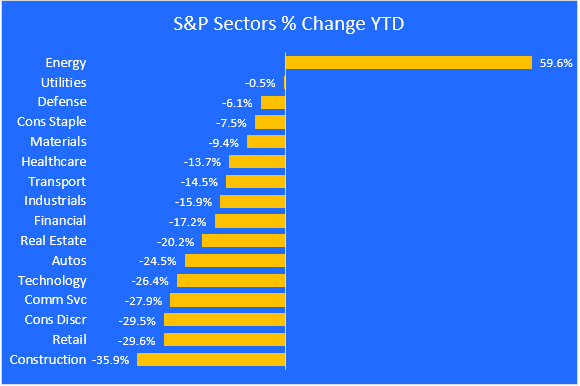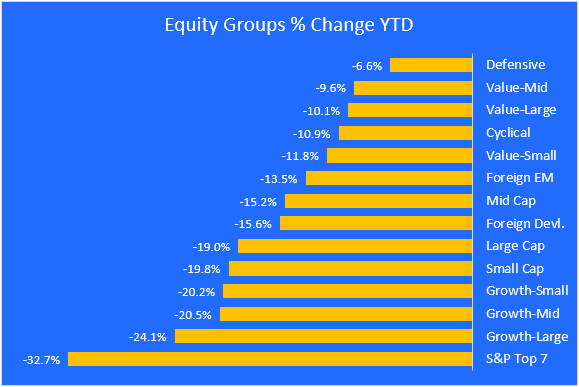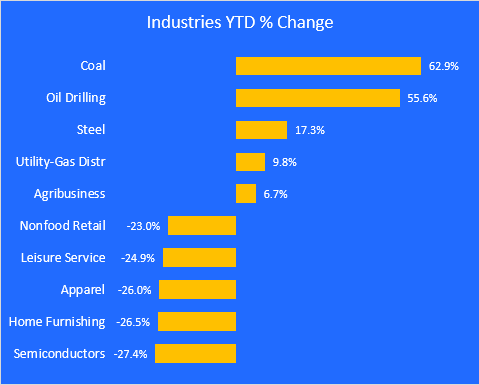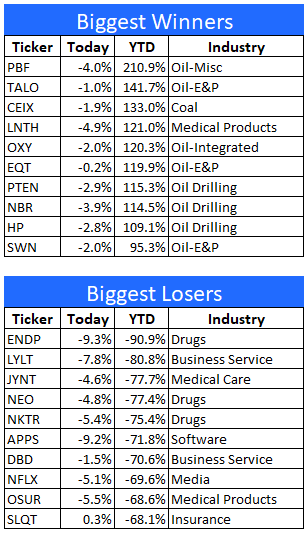Another failed rally.
The 1-Minute Market Report is tailored for those who want a quick recap of what's going on, without the usual fluff and filler. I try to focus on the main drivers of the current market action, and offer some brief commentary along the way.
A quick summary
- The S&P 500 is back to the cycle low set on May 19th.
- The rallies this year have been swift and powerful but they don't hold.
- The dip-buyers must now defend the bear market line at 3837 on the S&P.
- We are in a rolling bear market, with 65% of all stocks down 20% or more.
- An increasingly aggressive Fed, red-hot inflation, slowing economic growth, and the war in Europe are formidable headwinds.
- If the dip-buyers fail to hold the line at 3837, investor sentiment will take another hit.
Chart 1. Major Market Indices
We begin with the widest lens - the year-to-date percentage change in the major market indices - and zoom in closer from there.
Commodities lead the pack, with the surge in oil, coal, natural gas, gasoline, agricultural products all spiking higher due to strong demand and tight supplies. This trend will likely continue as long as the war in Ukraine continues and sanctions remain in place.
Blockchain is the worst performing asset class, with Bitcoin down by 58% from its November 2021 peak of 67,566.
Chart 2. S&P 1500 Sectors YTD Percentage Change
The best performing sector is Energy, up by 59.6% year-to-date. Utilities are in second place, nearly flat for the year. They are considered a safe haven from volatility, and they are doing a decent job of protecting investors from the worst that this market has dished out.
Home construction is the worst performing sector, as rapidly rising mortgage rates and home prices are discouraging buyers. The new mini-trend is buyers walking away from deals that they made just a few weeks or months ago.
Chart 3. Equity Groups Year-to-Date % Change
The next chart shows the performance of stocks that share certain characteristics, like value vs. growth, large vs. small cap, and cyclical vs, defensive. I created these groups to offer a way of visualizing the flow of investor money - where it's going and where it's coming from.
Defensive stocks like Boeing, General Dynamics and Lockheed Martin are benefitting from the war in Ukraine and the increased focus on national security around Greater Europe. Also included in this group are stocks from the Healthcare, Utilities, and Consumer Staples sectors.
The S&P Top 7 (AAPL, MSFT, GOOGL, AMZN, TSLA, NVDA, FB) drove the market higher last year, and now they are leading the market lower.
Chart 4. Industries YTD Percentage Change
Here are the biggest winners and losers among the 60 industries I track. It's no surprise that energy industries dominate the leader board. With sanctions, short supplies, and heavy demand, this looks like a durable trend. Steel and other industrial metal producers are doing well, as are agricultural businesses.
Home furnishings like tile, carpets, paint, furniture, appliances and bedding are struggling this year, and consumer basics like autos, soaps, cosmetics, apparel and phones are all being sold.
Software and semiconductors - the former market leaders - are now leading the way down.
Stock winners & Losers YTD
Charts 5 & 6. Best and worst performing stocks
The final two charts drill down into the specific stocks that have gained and lost the most year-to-date. 9 of the 10 top performers are involved in the energy business. This looks like a durable trend, and not just a reaction to the Russia sanctions.
Producers of steel and other metals are also doing well this year.
Of the ten biggest losers YTD, 5 are from the healthcare sector. Drug producers are especially hurting due to their high starting valuations, and because you can't sell what you don't have.
Final Thoughts
After several failed rallies, the market is back to its cycle low. Does this mean the the dip-buyers are gone for good? I wouldn't bet the ranch on it. They fled the scene this week, but I expect them to show up again next week, and try once again to take control away from the aggressive rally-sellers.
The situation in Ukraine is very fluid, and anything can happen. Expect more bouts of volatility (a euphemism for big down days) and more failed rallies.
It's an absolute certainty that the dip-buyers will eventually take the market to a new high, but I don't think we've seen the bottom yet. I'm betting that the -20% level will be breached, and they will have to draw the next line at -25%.
The great rotation out of tech and into energy and other commodities continues, and will probably keep going for the rest of the year, if not longer. And the rise of value over growth should remain intact. The same is true for foreign vs. domestic markets, once the picture on sanctions becomes more clear.
Regarding tech, I think the future belongs to AI, robotics, and cybersecurity. These companies are under the same price pressure that the big tech names are experiencing, but once they stabilize I think they will become the new leaders in the tech space.

